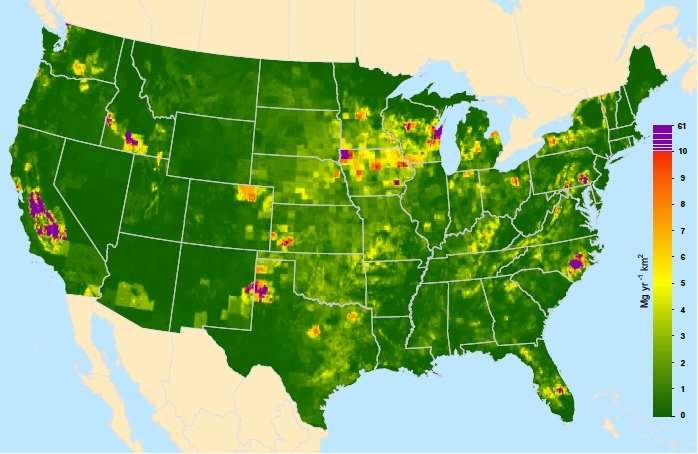Uncertainty surrounds US livestock methane emission estimates

A new study of methane emissions from livestock in the United States—led by a researcher in Penn State's College of Agricultural Sciences—has challenged previous top-down estimates.
The research was conducted because serious discrepancies exist between top-down estimates that suggest the U.S. Environmental Protection Agency is underestimating agricultural methane emissions by up to 90 percent, and bottom-up estimates accepted by the federal government showing lower emissions.
Top-down emissions estimates involve monitoring atmospheric methane concentrations by satellites or from air samples collected at high altitude by planes, and using models to estimate the sources of emissions. Bottom-up estimates take into account livestock populations and animal emission factors.
In their detailed analysis, researchers used a spatially explicit, bottom-up approach, based on animal inventories and feed-intake-based emission factors, to estimate enteric methane emissions for cattle and manure methane emissions for cattle, swine and poultry for the contiguous United States.
The researchers estimated methane emissions using a "gridded" approach, dividing the U.S. into 0.1 by 0.1-degree GIS units, which created cells from 31 square miles in the northern United States to 42 square miles in the southern part of the country.
"This level of detail enabled us to more accurately assess agricultural methane emissions based on activities involving livestock," explained lead researcher Alex Hristov, professor of dairy nutrition, who is a member of the current National Academy of Sciences Anthropogenic Methane Committee.
"We must have more specific information about methane emissions that combines local livestock populations and characteristics with distribution of landscape features—and a gridded inventory approach provides that," he said.
According to the EPA, the top three sources of anthropogenic methane in the United States are the combined energy sector—natural gas, petroleum systems and coal mining—which makes up 40 percent of the total; livestock, 36 percent of the total; and landfills, 18 percent of the total.
Methane emissions from livestock operations are the result of microbial fermentation and methanogenesis in the forestomach of ruminants and similar fermentation processes in manure from both ruminant and non-ruminant farm animals.
Methane is also produced from enteric fermentation in the digestive tract of non-ruminant herbivore species, such as horses, donkeys and mules, as a result of fermentation processes in their hindgut. However, "hindgut fermenters" do not produce nearly as much methane per unit of fermented feed as ruminants, so enteric or manure emissions from equine species were not included in this analysis. Neither were emissions from small ruminants such as sheep and goats, which are negligible in the U.S.
County-level, annual enteric methane emissions for all states were estimated for cattle only. A total of 3,063 counties in the contiguous U.S. were included in the cattle methane emission database.
Cattle inventories by county were obtained from the 2012 Census of Agriculture, which is the last census data currently available. Body weight data for cattle was derived from EPA records and dry matter feed intake was estimated based on National Research Council prediction equations for the various categories of cattle. Methane emission yield factors were calculated for each cattle category.
Overall, the research, which was published this month in Environmental Science and Technology, yielded total U.S. livestock methane emissions of 19.6 billion pounds per year. However, uncertainty surrounding that total is high, researchers acknowledged.
Compared with enteric methane, predicting methane emissions from manure is a more complex process and carries a larger uncertainty in the estimates, the researchers pointed out. Manure composition, type of storage facilities and manure retention time, and environment—particularly temperature—are among the factors that affect methane emissions from manure.
There is great uncertainty in both enteric and manure methane emissions from livestock, Hristov conceded. He said that research around the world has shown that variability in enteric methane emissions largely can be explained with variability in feed dry-matter intake. Nutrient composition of the feed is also important but has a lesser impact on enteric methane production.
"If methane emissions from livestock in this country really are twice as high as what is estimated now—and we don't believe they are—that would put a big target on agriculture to take measures to cut these emissions," said Hristov. "Having an accurate and spatially explicit assessment of methane emissions from livestock is critical for reconciliation of top-down and bottom-up approaches, and it's the starting point in any mitigation effort."
"Our analysis showed that the EPA's estimates are close to reality, but there is a discrepancy in the spatial distribution of emissions. And, our research revealed a great discrepancy with global models such as the EDGAR (Emission Database for Global Atmospheric Research) inventory."
More information: Alexander N. Hristov et al. Discrepancies and Uncertainties in Bottom-up Gridded Inventories of Livestock Methane Emissions for the Contiguous United States, Environmental Science & Technology (2017). DOI: 10.1021/acs.est.7b03332
Abstract
In this analysis we used a spatially explicit, simplified bottom-up approach, based on animal inventories, feed dry matter intake, and feed intake-based emission factors to estimate county-level enteric methane emissions for cattle and manure methane emissions for cattle, swine, and poultry for the contiguous United States. Overall, this analysis yielded total livestock methane emissions (8916 Gg/yr; lower and upper 95% confidence bounds of ±19.3%) for 2012 (last census of agriculture) that are comparable to the current USEPA estimates for 2012 and to estimates from the global gridded Emission Database for Global Atmospheric Research (EDGAR) inventory. However, the spatial distribution of emissions developed in this analysis differed significantly from that of EDGAR and a recent gridded inventory based on USEPA. Combined enteric and manure methane emissions from livestock in Texas and California (highest contributors to the national total) in this study were 36% lesser and 100% greater, respectively, than estimates by EDGAR. The spatial distribution of emissions in gridded inventories (e.g., EDGAR) likely strongly impacts the conclusions of top-down approaches that use them, especially in the source attribution of resulting (posterior) emissions, and hence conclusions from such studies should be interpreted with caution.
Journal information: Environmental Science & Technology , Environmental Science and Technology
Provided by Pennsylvania State University


















